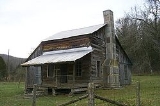
Parker-Hickman Farm Historic District
Encyclopedia
The Parker-Hickman Farm includes the oldest standing log structure in Buffalo National River
. The farm was homesteaded in the 1840's by settlers from Tennessee. It embodies an agricultural landscape with farmstead, extant fields (bench and bottomland), fencerows, roads, cattle gates, garden and orchard plots, wooded slopes and springs. Unlike most farms in the Ozarks the landscape is remarkably intact and provides insights and evidence spanning portions of two centuries of Ozark history; not randomly chosen, it conveys a feeling of enclosure and exemplifies adaptive use of topography. Among farms of its kind in Missouri and Arkansas it was once typical but now survives as a rare baseline example for Ozark yeomanry farms of mixed economies.Parker-Hickman was an agricultural enterprise that continuously operated until 1982 from a farmstead which exemplifies the entire period, and a rare one for the Ozarks since it survives. Clustered around the farmstead are several structures: barns, sheds smokehouse, privy, fences, stock feeders and house that represent a cross-section of rural vernacular architecture still in their original location.
Although other farms in the Ozark-Ouachita region had similar origins, with settlement patterns that evolved from subsistence to commercial agriculture, the Parker-Hickman farm is important because it survived intact. Until purchased by the National Park Service
the Parker-Hickman farm continued uninterrupted as an agricultural enterprise for more than one hundred forty-five years, a rare intact survival of a typical southern upland farm in the Ozark-Ouachita region.
Buffalo National River
The Buffalo River, located in northern Arkansas, was the first National River to be designated in the United States. The Buffalo River is slightly more than in length, with the lower flowing within the boundaries of an area managed by the National Park Service, where it is designated the '. The...
. The farm was homesteaded in the 1840's by settlers from Tennessee. It embodies an agricultural landscape with farmstead, extant fields (bench and bottomland), fencerows, roads, cattle gates, garden and orchard plots, wooded slopes and springs. Unlike most farms in the Ozarks the landscape is remarkably intact and provides insights and evidence spanning portions of two centuries of Ozark history; not randomly chosen, it conveys a feeling of enclosure and exemplifies adaptive use of topography. Among farms of its kind in Missouri and Arkansas it was once typical but now survives as a rare baseline example for Ozark yeomanry farms of mixed economies.Parker-Hickman was an agricultural enterprise that continuously operated until 1982 from a farmstead which exemplifies the entire period, and a rare one for the Ozarks since it survives. Clustered around the farmstead are several structures: barns, sheds smokehouse, privy, fences, stock feeders and house that represent a cross-section of rural vernacular architecture still in their original location.
Although other farms in the Ozark-Ouachita region had similar origins, with settlement patterns that evolved from subsistence to commercial agriculture, the Parker-Hickman farm is important because it survived intact. Until purchased by the National Park Service
National Park Service
The National Park Service is the U.S. federal agency that manages all national parks, many national monuments, and other conservation and historical properties with various title designations...
the Parker-Hickman farm continued uninterrupted as an agricultural enterprise for more than one hundred forty-five years, a rare intact survival of a typical southern upland farm in the Ozark-Ouachita region.
See also
- Buffalo River State Park Historic DistrictBuffalo River State Park (Arkansas)Buffalo River State Park was an Arkansas state park, established in 1938, that was absorbed into Buffalo National River when the Federal park was established in 1972. The area is now known as Buffalo Point...
- Rush Historic DistrictRush Historic DistrictThe Rush Historic District is a zinc mining region of the Ozark Mountains in Arkansas. Now located within Buffalo National River, the district includes ruins dating from 1880 to 1940...
- Big Buffalo Valley Historic DistrictBig Buffalo Valley Historic DistrictThe Big Buffalo Valley Historic District, also known as the Boxley Valley Historic District, is notable as a cultural landscape in Buffalo National River. It comprises the Boxley Valley in northern Arkansas, near the town of Boxley. The valley includes a number of family-operated farms, primarily...

